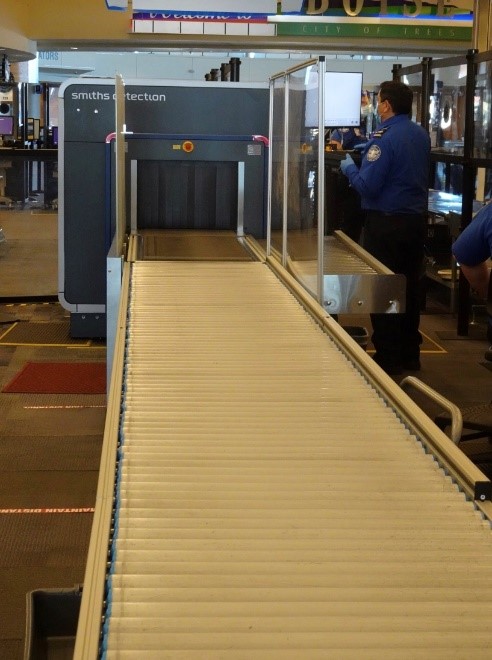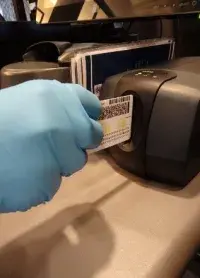
BOISE, Idaho - As the holiday travel period approaches, the Transportation Security Administration (TSA) provided an overview of new technology and modified procedures that are in place at Boise Airport (BOI).
TSA is using Credential Authentication Technology (CAT) at BOI to confirm the validity of a traveler’s photo identification and flight details. When travelers approach the travel document checking podium, a TSA officer will ask the traveler to provide their photo identification only and will insert it into the CAT unit. There is no need to hand over a boarding pass to the TSA officer, reducing potential cross-contamination. CAT units are also able to identify fraudulent documents and those that have been tampered with. Note that travelers will still need to check-in with their airline in order to be able to board their flight.
TSA has also installed a computed tomography (CT) scanner in the security checkpoint to screen carry-on luggage. The scanners utilize state-of-the art, 3-D X-ray technology. TSA officers are able to manipulate the X-ray image on-screen to allow for a better view of the bag’s contents, increasing the potential for a TSA officer to clear the contents of a bag without having to physically open it. Reducing the number of bag checks is beneficial since it reduces potential touchpoints between traveler and TSA officer. When the CT scanner is in use, travelers do not need to remove electronics, travel-size liquids or food from carry-on luggage.
In November, TSA completed installation of acrylic barriers in the security checkpoints at BOI. The barriers are in areas where TSA officers typically interact with travelers including the travel document checking podium, the divesting area where travelers prepare their carry-on property for x-ray screening and in the bag check area. Travelers will also hear the voice of TSA officer amplified in the divesting area to help facilitate communication for that step of the travel process.
For those who are considering travel during the holiday period, TSA nationwide has modified its procedures as part of its “Stay Healthy. Stay Secure.” Campaign to include:
- All security officers wearing face masks and gloves during the screening process. If a security officer is working in close proximity to travelers, they are also required to wear eye protection or a face shield. Security officers will change their gloves after each screening position rotation, after a pat-down or upon a passenger’s request.
- Reduced physical contact due to the installation of acrylic barriers that limit exposure between security officers and travelers.
- Social distancing leading up to and in the security checkpoint environment.
- Increased frequency and intensity of cleaning and disinfecting surfaces in the security checkpoint including bins. This is no substitute for practicing good hygiene while traveling. Travelers are encouraged to wash their hands before and after going through the checkpoint.
If you have made plans to travel, here are some steps you can take right now to be prepared:
Tip 1: Don’t forget your mask
- Bring and wear a mask when going through the security screening process. Plus, it never hurts to pack an extra mask or two for use during your air travels.
- Travelers will be asked to momentarily remove their masks to verify their identity.
- The Boise Airport requires passengers over the age of two (2) to wear a mask that completely covers the nose and mouth throughout the airport.
Tip 2: Pack the pandemic essentials
- Bring disinfectant wipes and hand sanitizer. TSA is allowing travelers to bring one liquid hand sanitizer container, up to 12 ounces per passenger, in carry-on luggage. Be prepared to remove your large hand sanitizer container from your carry-on for special screening. Bring as many pre-moistened wipes as you like.
- Bring an empty reusable beverage container (even an empty plastic water bottle). Fill it up on the secure side of the checkpoint after you go through screening to stay hydrated during your flight.
Tip 3: Enroll in TSA PreCheck® now to expedite screening and reduce touchpoints
- Travelers who are enrolled in TSA PreCheck® don’t have to remove their shoes, belts, lightweight jackets, electronics or their bag of travel-size liquids and gels. Not only is that convenient, but during a pandemic, it reduces touchpoints during the screening process. An enrollment center is located in Staples at 6299 N. Eagle Road in Boise. It is open Monday through Friday from 10 a.m. to noon and 1 p.m. to 5 p.m.
Tip 4: Pack those gifts, but please do not use wrapping paper
- TSA recommends against wrapping gifts when packing them for a flight. Wrapped items are screened just like any other item. If a wrapped item alarms the security screening technology in carry-on or checked luggage, a TSA officer may have to unwrap it to determine what the item is. Consider traveling with unwrapped items or placing them in a gift bag, gift box or putting a festive bow on the item for easy access and resolution.
Tip 5: Download the free myTSA app and follow @TSA on Twitter
- The free, downloadable myTSA app is a traveler’s best friend and a trusty source for last-minute travel questions. It provides 24/7 access to the most frequently requested airport security information as well as real-time data on airport weather delays. Use the searchable “Can I Bring” database, which is available on the App Store or Google Play.
Tip 6: Be Aware of Boise Airport Access Restrictions
- Access to the public areas of the Boise Airport terminal is restricted to individuals who can demonstrate they fall within one of the following categories:
- Ticketed airline passengers;
- An individual accompanying a ticketed airline passenger, provided the passenger needs assistance with arrival or departure;
- Individuals whose employment requires access to public areas;
- Individuals who have been authorized by airport officials or have a business need to access the public areas;
- Individuals in vehicles who are at the passenger pick-up and drop-off locations waiting for or dropping off ticketed passengers; and
- Individuals in rental vehicles at the airport pick up or drop off rental car locations.
Travelers are reminded to follow the Centers for Disease Control and Prevention (CDC) travel guidance as well as local and state advisories regarding COVID-19. For more information about the TSA response to COVID-19, please visit tsa.gov.

